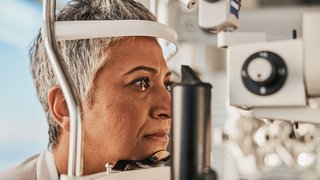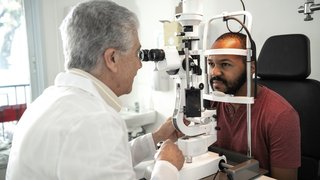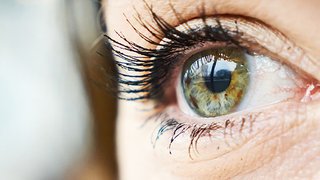4 conditions with signs and symptoms that arise in the eyes
May 26, 2021

Too often, diseases such as high blood pressure progress without noticeable symptoms – patients experience no obvious physical changes until something serious happens.
But your retina – the light-sensitive layer of the eye that helps form visual images – are a unique area of the body that lets us merge the present with the future.
The eyes are full of tiny blood vessels that are affected by diseases that impact blood flow. At UT Southwestern's Department of Ophthalmology, we see patients with a range of diseases that have caused serious, sometimes irreversible retinal damage, such as:
- Diabetes
- High blood pressure
- Autoimmune conditions
- Genetic conditions
Examining the retina provides clues to developing disease processes that may have major, negative effects on your vision. Sometimes, we detect potentially life-threatening conditions.
That's part of the reason why regular eye screenings are so important. In general, adults with no known vision problems should have an eye screening every one to two years. However, if you -have a health condition that may affect the eyes, your doctor might suggest having your eyes examined more frequently.
Unfortunately, many patients have more than one disease that can affect their retina. Let's discuss four types of systemic diseases and how they can affect your eyes, what treatments are available, and how to potentially prevent severe vision damage.
Diabetes
Diabetes is a disease in which blood glucose (blood sugar) levels are too high, which can cause significant changes in the large and small blood vessels of the body. Diabetic retinopathy is the most common diabetes-related eye disease in U.S. adults and a leading cause of blindness, according to the Centers for Disease Control and Prevention (CDC).
There are two types of diabetic retinopathy:
- Nonproliferative: Dilated blood vessels (microaneurysms) and areas of retinal bleeding (hemorrhages) develop in the retina. These are signs that your eye is changing because of the diabetes though they do not always cause vision changes. You may also have swelling in the central retina (macular edema) which is more likely to cause vision changes.
- Proliferative: You develop abnormal blood vessels (neovascularization) that can bleed or pull on the retina and cause of retinal detachment, which can lead to blindness.
What matters most in terms of retina damage is how long you've had diabetes and how well it has been controlled. Often, patients with type 1 diabetes are more at risk for eye problems since the disease typically starts in childhood. However, patients with type 2 diabetes may live for years without knowing they have the disease, putting them at high risk for retinal concerns.
Ideally, patients will get checked regularly for diabetes. If you have it, work with your doctor to control your blood sugar and blood pressure, which should help limit the effect diabetes can have on your body.
Treatment options: Retinal detachments can potentially be fixed with surgery if caught early; however, the surgery requires a long recovery. Even with repair, retinal detachments can cause serious effects on vision, including blindness.
Swelling and abnormal blood vessels may be treated with injections or laser treatment to help stabilize the eye and prevent a retinal detachment. However, the treatments do not address the underlying diabetes.
"Ideally, patients should avoid developing type 2 diabetes. Get checked for diabetes regularly and, if you have it, work with your doctor to make sure your blood sugar and blood pressure are well-controlled. Research shows that both of these matter greatly in controlling the havoc diabetes can wreak on the body and on the eyes."
Angeline Wang, M.D.
High blood pressure
High blood pressure can contribute to serious conditions called retinal artery or retinal vein occlusions – essentially blood clots that lead to a "stroke" in the eye. Both conditions can cause sudden decreased vision. You can also develop swelling (macular edema) with retinal vein occlusions.
Another concern is hypertensive retinopathy, in which chronic high blood pressure causes damage to the retinal blood vessels, leading to poor blood flow and damage to the retina or optic nerve.
Controlling your blood pressure is essential to whole-body health, and it can also help prevent potentially irreversible vision damage.
Treatment: Artery occlusions in the eyes are considered medical emergencies. Patients will get a workup in the emergency room similar to the process for a stroke in the brain with the goal of preventing further retinal artery occlusions or strokes in the future. Vein occlusion can be treated with laser therapy or injections.

Autoimmune conditions
Systemic autoimmune conditions such as these can affect blood vessels, organs, and circulation in various parts of the body, including the eyes:
- Lupus
- Rheumatoid arthritis
- Granulomatosis with polyangiitis (GPA), an inflammatory condition that can affect the ears, nose, throat, lungs, and kidneys
- Behcet's disease, an inflammatory condition characterized by mouth, skin, and genital sores and that can affect the joints and central nervous system
Treatments: If we detect inflammation in the eye, we can treat the inflammation with steroid injections or drops and can refer you to a rheumatologist or another specialist for further diagnosis and advanced care.
Genetic conditions
Certain congenital conditions – diseases people are born with – can cause small tumors to grow on the nerves, blood vessels, or vital organs, including in the eyes.
Von Hippel-Lindau (VHL) syndrome is one such condition. VHL can lead to the development of tumors throughout the body, including blood vessel tumors called hemangioblastomas. When these develop in the eyes, they're called retinal angiomas, which can leak fluid and lead to significant swelling or even retinal detachment. Left untreated, these cysts can cause vision loss.
While most patients with congenital diseases know about their condition, the ophthalmologist can sometimes serve as the first line of diagnosis. Once VHL is diagnosed, it is critical to begin the screening process to look for tumors in other parts of the body.
Treatments: Von Hippel-Lindau syndrome-related retinal angiomas may not cause problems until they grow large enough to affect vision or begin to leak fluid. Treatment is usually laser or cryotherapy.
The future of retina disease care and diagnosis
As an academic medical center, UT Southwestern sees a high volume of patients with complex diseases that affect the retina. We are currently involved in a large retrospective study at Parkland Hospital to observe the outcomes of patients with advanced diabetic retinopathy who need surgery. Our goal is to determine which surgical techniques give patients the best results. We hope to use this information to plan more precise treatments and surgeries.
In the future, we want to explore the use of artificial intelligence (AI) in diagnosis of retinal diseases. This research would involve taking pictures of the retina and correlating those images with cardiovascular disease changes we see in the blood vessels. Using the trends data, we can give patients quicker, more efficient, and potentially more accurate ophthalmologic treatment and coordination of care.
The eyes offer a window into your overall health. Getting regular retina checkups helps preserve your vision and can alert you to severe health issues before serious symptoms arise. While seeing an ophthalmologist is not a replacement for regular physical exams, your eye specialist can offer a double-check, keeping you more informed of your overall health.
Schedule a visit with an ophthalmologist by calling 214-645-2020 or request an appointment online.
Total eye health
UT Southwestern's ophthalmologists have extensive experience treating the most common and complex eye conditions, which translates to the best possible care for our patients. Our team's expertise and accessibility make UTSW a one-stop shop for comprehensive eye care.











